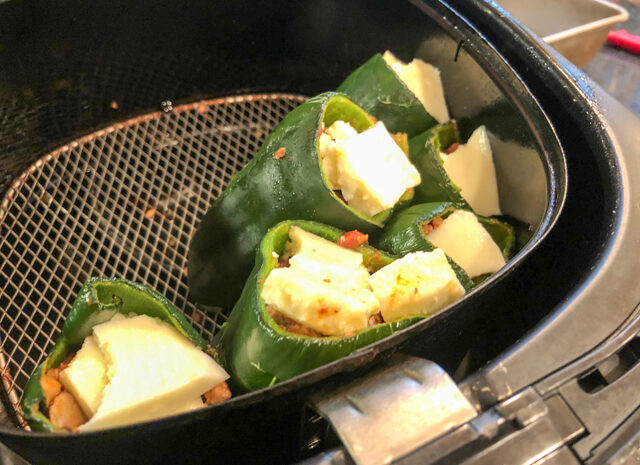In recent years, air frying has rapidly gained popularity as a healthier alternative to traditional frying methods. Promoted as a way to enjoy crispy, delicious foods without the excess oil and calories associated with deep frying, air fryers have become a staple in many kitchens. But what exactly is air frying, how does it work, and why is it considered a healthier cooking method? Let’s dive into the science behind air frying to understand its benefits and why it’s revolutionizing the way we cook.
What is Air Frying?
Air frying is a cooking technique that uses hot air circulation to cook food, producing a crispy outer layer similar to deep frying but without submerging the food in oil. An air fryer is essentially a small, powerful convection oven. It uses a heating element and a high-speed fan to circulate hot air around the food. This rapid circulation of hot air cooks the food quickly and evenly, giving it a fried texture and flavor with only a fraction of the oil traditionally required.
How Does an Air Fryer Work?
The operation of an air fryer is rooted in two primary physical processes: convection and the Maillard reaction.
- Convection Cooking: Convection is the transfer of heat through the movement of air. In an air fryer, the heating element generates intense heat, while the fan circulates this hot air around the food at high speeds. This constant flow of hot air ensures that the food is cooked evenly on all sides. Unlike a traditional oven, where heat distribution can sometimes be uneven, the air fryer’s design allows for uniform cooking, leading to a consistent, crispy exterior.
- The Maillard Reaction: The Maillard reaction is a chemical reaction between amino acids and reducing sugars that gives browned food its distinctive flavor. This reaction occurs when food is exposed to high heat, typically above 300°F (150°C). In an air fryer, the intense heat and rapid air circulation cause the surface of the food to dry out and brown, creating that sought-after crispy texture. The Maillard reaction is responsible for the golden-brown color and rich flavors of air-fried foods, making them taste as if they’ve been deep-fried.
The Health Benefits of Air Frying
One of the main reasons people turn to air frying is its potential health benefits. By reducing the amount of oil needed to achieve a crispy texture, air frying can lead to healthier meals in several ways:
- Lower Fat Content: Traditional deep frying involves submerging food in hot oil, causing it to absorb a significant amount of fat. This can dramatically increase the calorie content of the food. Air frying, on the other hand, requires little to no oil. A tablespoon of oil is often enough to coat the food and achieve a crispy exterior. This reduction in oil can cut the fat content of the food by up to 75%, making air-fried dishes significantly lower in calories compared to their deep-fried counterparts.
- Fewer Harmful Compounds: When oils are heated to high temperatures, they can break down and produce harmful compounds like acrylamide, a chemical that has been linked to an increased risk of cancer. Deep frying is particularly prone to producing acrylamide due to the prolonged exposure of food to high temperatures. Air frying, with its shorter cooking times and lower oil usage, reduces the formation of acrylamide, making it a safer option.
- Retention of Nutrients: Deep frying can destroy or degrade certain nutrients in food due to the extreme heat and prolonged cooking time. Air frying, which uses less intense heat and shorter cooking durations, helps preserve more of the food’s nutrients. This means that air-fried vegetables, for example, retain more of their vitamins and minerals compared to those that are deep-fried.
- Reduced Risk of Heart Disease: Consuming foods high in trans fats and saturated fats, which are common in deep-fried foods, has been linked to an increased risk of heart disease. Air frying, by significantly reducing the amount of oil and fats used in cooking, can support a heart-healthy diet. Foods prepared in an air fryer tend to have lower levels of unhealthy fats, which can help reduce the risk of cardiovascular problems. If you want more information about The English Diabetic Air Fryer Cookbook, you may visit their page to learn more.

Air Frying vs. Other Cooking Methods
While air frying offers numerous benefits, it’s important to compare it with other cooking methods to understand where it stands.
- Air Frying vs. Deep Frying: As mentioned, air frying uses significantly less oil than deep frying, leading to lower fat content and fewer calories. However, air frying may not always produce the exact same texture as deep frying, particularly with certain foods. While air fryers can achieve a crispy exterior, it may not match the deep, rich crunch of traditionally fried foods. Nonetheless, the health benefits often outweigh this slight difference in texture.
- Air Frying vs. Baking: Baking is another healthier cooking method, as it typically requires little to no added fat. However, air frying has the advantage of cooking food more quickly and evenly due to the rapid circulation of hot air. Additionally, air frying can produce a crispier texture than baking, making it a preferred method for certain dishes like fries or chicken wings.
- Air Frying vs. Grilling: Grilling is another popular cooking method that can be quite healthy, especially when it involves lean meats and vegetables. However, grilling requires outdoor space and can be weather-dependent. Air frying offers the convenience of indoor cooking with similar health benefits. It also eliminates the risk of charring, which can produce harmful compounds when grilling.
Tips for Healthier Air Frying
To maximize the health benefits of air frying, consider the following tips:
- Use Minimal Oil: While air frying requires less oil than deep frying, using too much oil can still add unnecessary calories. Use a spray bottle to lightly coat your food with oil, or toss it in a small amount of oil before air frying.
- Choose Healthy Oils: Opt for heart-healthy oils like olive oil, avocado oil, or coconut oil. These oils have higher smoke points and provide beneficial fats that support overall health.
- Avoid Overcrowding the Basket: For the best results, avoid overcrowding the air fryer basket. Allowing space between the food pieces ensures better air circulation, leading to crispier and more evenly cooked dishes.
- Experiment with Seasonings: Air frying brings out the natural flavors of food, so use a variety of herbs and spices to enhance the taste without relying on excessive salt or unhealthy seasonings.
- Monitor Cooking Times: Since air fryers cook food quickly, it’s easy to overcook if you’re not paying attention. Follow recipes closely and check the food regularly to avoid burning or drying out your dishes.
Conclusion
Air frying offers a unique combination of convenience, flavor, and health benefits. By using hot air circulation and the Maillard reaction, air fryers create delicious, crispy dishes with less oil and fewer harmful compounds than traditional frying methods. Whether you’re looking to cut down on calories, reduce unhealthy fats, or simply enjoy a quicker, more efficient cooking process, air frying is a versatile and healthy option worth exploring. By understanding the science behind air frying, you can make informed choices that enhance both your diet and your culinary experience.

